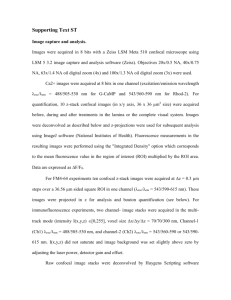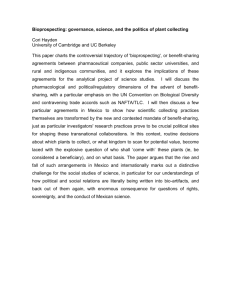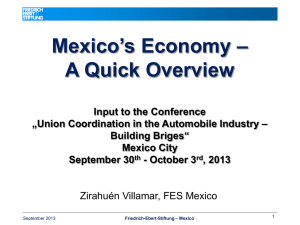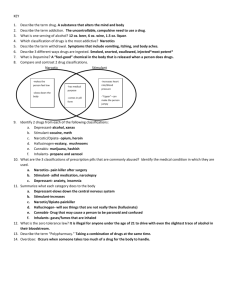An Analysis of SCIAN at ten years of its creation , a
advertisement
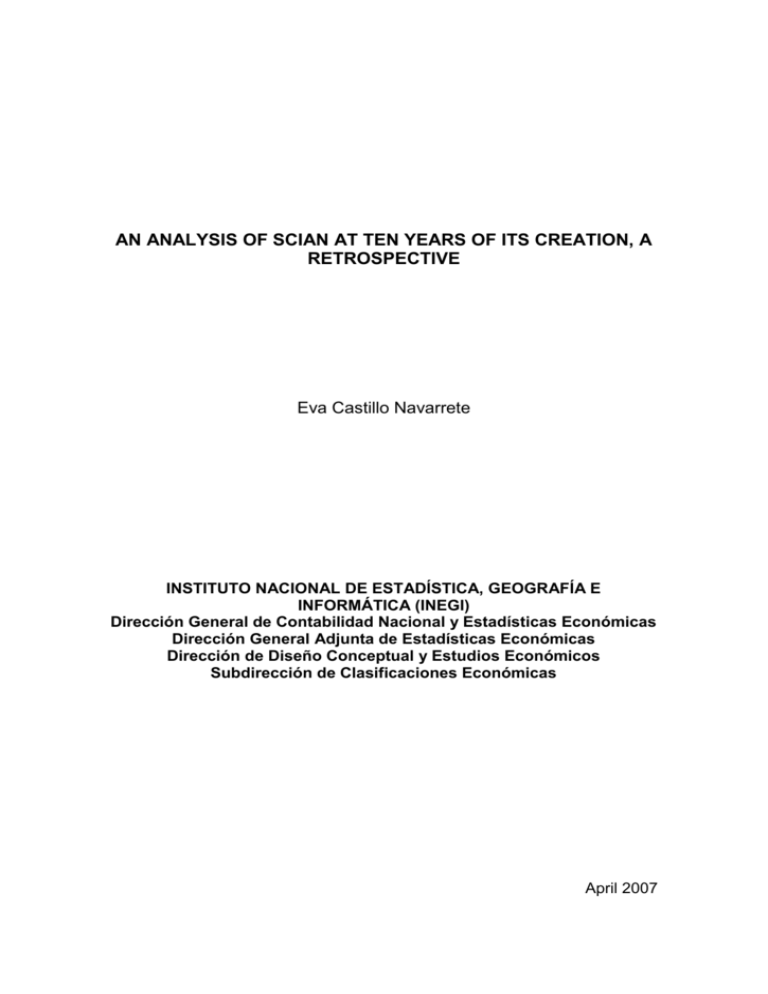
AN ANALYSIS OF SCIAN AT TEN YEARS OF ITS CREATION, A RETROSPECTIVE Eva Castillo Navarrete INSTITUTO NACIONAL DE ESTADÍSTICA, GEOGRAFÍA E INFORMÁTICA (INEGI) Dirección General de Contabilidad Nacional y Estadísticas Económicas Dirección General Adjunta de Estadísticas Económicas Dirección de Diseño Conceptual y Estudios Económicos Subdirección de Clasificaciones Económicas April 2007 Introduction The Sistema de Clasificación Industrial de América del Norte (SCIAN) is depositary of the heritage on economic classifications held by the Instituto Nacional de Estadística Geografía e Informática (INEGI).The implementation of this classification in the Institute has progressed considerably, a process which has become fundamental in updating SCIAN because it has put its operationality to the test. The project which began the implementation of the first version of the 1997 SCIAN Mexico was the 1999 Economic Censuses and the diffusion of statistics was done for the only time under two classifications, the Clasificación Mexicana de Actividades y Productos (CMAP) – classification used before SCIAN- and the 1997 SCIAN. In the course of its application in the diverse INEGI’s statistical projects (census, surveys, foreign trade statistics, National Accounts System, in the development of the Input-Output Tables), the direct responsible persons –experts in the operation of the economic units classified to the different SCIAN sectors- have faced classification difficulties which have to be solved with the new version of the classification, planned to be brought to light in 2007 and which its implementation will take place in the 2009 Economic Censuses. SCIAN is a regional classification because it is essential that truly compatible economic classifications exist in a free trade zone; this implies that both its development and update are coordinately done with Canada and the United States. The already published SCIAN versions (1997 and 2002) and the one to be published (the next one is the 2007 version) respond to the trilateral agreement of quinquennial updates of SCIAN taken by the national statistical agencies of Mexico, Canada and the United States in order to avoid that the classification becomes outdated, adapting it to the changing circumstances of economies in constant transformation. However, despite its constant revisions and updates, SCIAN has a scope and limitations like any other classification, which become evident during the operation of the classification, in the comparison of data and when it is surpassed by the user’s data demands. The Economic Classification Subdirection, SCIAN Mexico direct custodian, participates in the regional field as a member of the Trilateral Steering Committee coordinating the tasks agreed by the three countries to update SCIAN (there is no version for the three countries, each country has its own version and in it recognizes the trilateral agreement level, as it is shown in the body of the document) and in the national sphere it organizes, coordinates and carries out the update of the classification; in this way, the Mexican version of SCIAN is a result of the joint effort of the areas involved in the generation of statistics, the participation of external experts (representatives of associations and institutions, businessmen of diverse economic activities) and of the Economic Classification Subdirection. The discussions among the participant areas are relevant because the experts in the operation of the economic units provide their knowledge and experience in data collection, while the responsible persons of the economic classification can accurately indicate the scope and limitations of the classification. 2 This paper describes the follow-up of the problems identified during the application of SCIAN in INEGI’s statistical projects and the results make clear which are the concepts and categories whose content is necessary to clear, broaden, shorten or update. The characteristics of SCIAN –both its scope and limitations- which help to define the field of responsibility of the classification and of the projects are explained in first place. Furthermore, one of the goals sought with the analysis is to clear and make explicit the use of practical considerations, such as the application of the production function concept. On the other hand, the paper deals with the topic of comparability at the national and international level because there might be some confusion on this concept, and the work followed for the SCIAN 2002 revision process is made known, as well as the topics to be negotiated on the classification’s 2012 revision. SCIAN Scope As all classifications, SCIAN is a theoretical tool which orders what it tries to classify; in this case, SCIAN is a classification of economic activities, and as it happens in any classification, the categories that represent those activities are developed starting from the search of shared characteristics. It is a reality that the classification does not reflect all the existing business models in the economy, since it would be a too ambitious goal which would lead to have an unmanageable number of categories, even more if one considers that business are diversifying their production more and more and looking for innovations to make them more competitive; besides, the greater the number of activities categories, the less significant the data would result. However, despite these limitations, SCIAN is a state-of-the-art classification, periodically reviewed to reflect the most significant changes in the economic activities SCIAN is an economic activities classification Economic activities are classified in this classification, understood as a set of actions conducted by an economic unit in order to produce or to provide goods and services. SCIAN is a universal use classification SCIAN classifies economic activities and tries to address the majority of the user’s needs on information classification; it is a classifier used to collect data from diverse economic units, such as businesses, households, individuals; it can be used to register economic units through administrative records, for example. It can be used by public or private institutions. SCIAN’s hierarchic structure allows the statistical programs to adopt the level that suits their data needs SCIAN is composed of 20 activity sectors: five sectors are essentially goods producers and 15 are completely service providers. SCIAN’s hierarchic 3 structure is formed by five aggregation levels: sector (the most aggregated level), subsector, industry group, industry and class of activity (the most disaggregated level). The first four levels constitute the trilateral classification, the one that is common among the three countries, and the last level, the activity class, was reserved so that each country could make a greater breakdown according to its national statistical requirements. However, trilateral agreements in different SCIAN levels were established in some cases, as explained below. SCIAN’s hierarchic structure is useful since the statistical programs which do not have the conditions to provide data for all levels –either because of the objective of the project, the observation unit being used, disclosure problems, budgetary reasons, among others- can collect and publish information at aggregated levels, provided they fulfill the norm of not adding parts of categories that correspond to different agreed trilateral or national categories. SCIAN allows the comparison of economic activities data at the trilateral level SCIAN allows the collection of economic activities statistics and its comparison among the three countries which developed SCIAN, under the limitations noted below. SCIAN allows the comparison and completion of economic activities data within INEGI and at the national level It allows the collection of economic activities data and the comparison and completion of such statistics both within INEGI [which addresses the following statistical programs: censuses, sampling surveys, use of administrative records, derived statistics (National Accounts System), statistics integration projects generated by public, private and social sectors institutions, sociodemographic and economic studies projects] and at the national level (by means of the complementariness of administrative records data generated by other institutions). The correspondence between SCIAN categories and other economic activities classifications is established at the theoretical level The correspondence tables are an important tool for the comparison of statistical data gathered and presented in accordance with different classifications. However, correspondence tables between SCIAN and other classifications are only one way to theoretically link the classifications; i.e., to make them equivalent at the conceptual level, but they are not sufficient to allow for the comparison of data in a practical way, because it is not possible in all cases to directly obtain values for all of the parts in which a SCIAN category is divided when it is compared to other classification and vice versa (except for the case where the correspondence is established between categories which have exactly the same content). 4 SCIAN limitations SCIAN is the result of the application of theoretical concepts and practical considerations. The pure use of the production function criterion as the base of the classification, which in theory would permit to produce comparable statistics among the three countries, has been recently questioned; the homogeneous use of the criterion in all of the categories has also been debated. Thus, it is emphasized that the production function criterion is applied as far as possible throughout the classification. For that reason it is necessary to clear the comparability aspects: International comparability SCIAN has conceptual comparability in the sense that the same theoretical framework –the production function- is used for its development, because although there are limitations due to practical considerations, these have been agreed or at least accepted by the three countries. SCIAN defines “comparable” as the agreement by the three countries of the same content in the trilateral categories. The three countries have not reached an agreement on a comparability understood as “exactly equal” because of the underlying differences in terms of observation units and methodologies (temporality, reference periods, data collection strategies, geographic and thematic scope). We can not speak either of an agreement at the level of elaboration of "correspondence tables" only because we have trilateral agreements in most of the classification categories which means the same categories with the same content, and furthermore, we can not speak of comparability in the way defined by the dictionary: “to establish differences or similarities between things”. The last two cases might have been solved using each country’s former classifications, but we must remember that the revision of Mexico’s, Canada’s and the United States’ classifications was imposed basically because of a pair of reasons: its obsolescence and because it is essential that truly compatible economic classifications exist in a free trade zone. The production of statistics of the three countries under the previous rules gives as result statistics which are conceptually similar but "not exactly equal". SCIAN was developed under the production function principle: “economic units which have similar production processes are classified to the same activity class, and classes are delimited to the extent possible, according to production processes”, but why in some cases we grouped in the same categories artisan activities along with activities with more mechanized processes for the production of the same goods? The three countries assessed having in the same category the production of the same goods elaborated with diverse technologies but following the same basic process, versus having different categories for such goods produced with different technologies and also taking in consideration that there is no universal definition that can help to delimit for sure where an artisan activity stops being so because of the use of some technology; on the other hand, each country has the collection instruments as a 5 valuable tool, since they could be able to identify through their variables the technology used for the goods production and from its analysis to offer useful information for the user who requires that type of data, that is to say, how much artisan activity represents each class. The same question could be raised for categories which classify the manufacturing of the same products but some start their processes from recycled material and others from new material or from a combination of both, which could take one to think that their production processes are different. Another case refers to the classification of units that manufacture a good by their account and risk in the same category as the units that manufacture a good or part of a good (except when specific categories exist) by request of a third party; some of these do not initiate their process in the same way, for example, some can initiate from the cut of the fabric to make clothes, and others from the seam of the already cut parts of the clothes. An additional limitation with regard to international comparability is the way in which each country’s activities that are developed within an economic unit are combined, which means that the classification assigned to each of them not necessarily reflects the same form of organization of the economic units; i.e., the combination of activities differs to a certain extent in the three countries, then a structure that specified those combinations in SCIAN could have been developed, but the resulting statistical data could had been possibly insignificant or null for any of the three countries. In these three cases, to what point does the opening of classification categories should arrive? In an ideal world there could be as many categories as possible activities, or that each observation unit made a sole activity, in this way it would be unquestionably possible to classify each unit to a certain category. Nevertheless, practical aspects should be taken into account and not to lose sight of excellent tools like the collection instruments and the complementariness between the statistics of the different statistical projects. Different levels of trilaterally agreed categories In the development of SCIAN, the three countries defined that the most detailed trilateral aggregation level would be the five-digit level (industry), however some agreements were established at the sector (two-digit), subsector (three-digit) or industry group (four-digit) level, then the “comparability” among the three countries is at a more aggregated level in the following cases: Trilateral agreements at the sector level: 22, Electricity, water and gas supply by pipes to the final consumer; 43, Wholesale trade; 46, Retail trade, and 93, Government and international organizations activities. 6 Trilateral agreements at the subsector level: 522, Non-stock credit and financial intermediation institutions; 562, Waste management and remediation services; 812, Personal services, and 813, Associations and organizations. Trilateral agreements at the industry group level: 2381, Laying of foundations, assembly of prefabricated structures and works in exteriors; 3152, Cut and Sew Apparel Manufacturing; 5231, Stock exchanges, currency exchanges and exchange centers; 5239, Other investment and stock intermediation services; 5241, Insurance and bonds institutions; 5242, Services related to insurance and bonds; 5311, Lessors of residential buildings and other real estate; 5313, Services related to real estate, and 6111, Elementary, secondary and special education schools. Therefore, the breakdown of these categories below the levels that were pointed out are considered as national detail. The rationale of establishing agreements at different SCIAN levels obeyed to reasons such as: different forms of organization of the economic units, different legislation, divergent interests of the institutions for the most detailed levels, limitations of resources and time. An important issue related to the classification’s structure was the adoption of the general operative norm in the sense that SCIAN’s industries should be economically important and publishable. It was anticipated that each country would publish additional categories, subdivisions of the industries, to present data on activities that were nationally important. In the chemical industry for example, the majority of the activities that were identified in a country do exist in the others. However, frequently an activity is not economically significant in the same degree in all the countries. In addition, the information of some important activities cannot be published by a country in particular for confidentiality reasons, such as the case of the manufacturing of matches in Canada. The observation unit It is true that the differences in the observation units (the units on which the data will be required), however defined by each country, cause considerable problems when comparing data. The problem would not seem as critical however if we conceptualize activities as observation units, i.e., as “activities observation units”; for example, the three countries have the manufacturing of breakfast cereals and this activity, according to the trilateral agreements, is classified to the category 31123, Breakfast Cereal Manufacturing, thus comparability among the three countries is closer in statistical terms. But, if any one country would have breakfast cereals manufacturing and other activity(ies) as observation unit, the statistical result would be much less similar. Different methods for collecting data and lack of administrative records that support the classification of the economic units The different methods to collect data (censuses or surveys) in each country, designed with collection strategies in agreement with the idiosyncrasy and the 7 possibilities of each one of them could make the "comparability" between the statistics generated to be complex, because it is necessary to take into account several considerations (collection method, geographic scope, frequency, etc.). Unlike our country, Canada and the United States have the support of administrative records. It is very likely that when the classification of the economic units in a census or surveys is supported on information obtained from administrative records or from other sources that allow for the constant feedback between the area responsible of the classification, the data collection area, the area which designs the collection instruments and the institutions in charge of the registers, the classification is more precise, provided there is a close follow-up of the economic units and the activities they carry out, as well as the follow-up of the agreements established between the institutions since that proximity allows to improve the methods and even the collection instruments. National comparability INEGI’s statistical projects In strict sense all SCIAN categories must be interpreted by INEGI in the same form; arbitrary classification criteria should not be applied, rather the criteria should be established in a homogenous form. Furthermore, in order that the results obtained by INEGI’s diverse statistical programs on a same subject are consistent and comparable to each other, in the sense of "exactly equal", one of the most important conditions is that the chosen observation units for the same universe and their methodologies are exactly equal. Nonetheless, the underlying differences between statistical projects are recognized, in terms of different observation units and methodologies (universe of study, frequency, reference period, data collection strategies, geographical and thematical scope), generated by the very own nature of the projects: economical statistics; National Accounts System and socio-demographic statistics programs; the two latter would additionally use –when necessary- complementary or different units (for example, households, individuals who do not work in any establishment or business but by the own, among others). In INEGI’s scope there is the possibility of offering to the user very similar results at the time of making comparisons between statistical projects of the same nature (censuses and economic surveys) and much more precise that in the international sphere. Also there is a great possibility of complementariness of the statistics between projects of different nature. Use of NAICS at the national level As within INEGI, the external users should interpret all of the SCIAN categories in the same way; the classification criteria to be used should be homogeneous, not arbitrary. However, it is recognized that its use in the country’s public or private institutions can have different purposes, so they could use the structure at a suitable level, as well as the different observation units and methodologies, according to their interests. The important thing is to establish collaboration agreements between INEGI and the institutions to the extent possible in order to agree methodologies and concepts and to work in the data complementariness. 8 Scope of the classification The organization of the activities in the classification may not directly address the information needs from specific users, due to its development criterion In this aspect, for example, the classification does not present in a single sector the set of economic activities which produce goods and services for tourists; goods and services related to information and communication technologies, and goods and services referred to cultural activities either. The activities that form these specific topics are classified to different NAICS categories in accordance to their production function. If one wanted to display statistics on those subjects it would require making rearrangements of the categories found in SCIAN’s structure. There are some analytical requirements which can not be satisfied by the classification. In special, if a great demand of information existed on the production of all the articles that contain plastic -SCIAN has subsector 326, Plastic and rubber industry-, such type of demand would not have place in SCIAN’s classification of activities due to the presence of plastic in many of the manufactured products. Many manufacturing activities, that incorporate plastic in their production in combination with other materials, are classified to other categories of the manufacturing industries and not in the abovementioned subsector, for example, footwear manufacturing or of furniture, which are classified to other categories. On the other hand, the users which require data for analysis based on demand can use statistics based on product classifications, instead of those generated with SCIAN. SCIAN classification does not solve observation unit problems In order to classify the economic units, it is necessary to determine first the observation unit of which it is required to collect information, to find out if it shares or not its trade name with other economic units, if it is an auxiliary or a producer unit and then start to research the activities it carries out; if the main activity should be determined based upon the established criterion or if predetermined criteria exist, as the case of the combined or integrated activities. That is, it is not competence of the classification to solve cases such as the following: to classify as a producer or not a warehouse that shares the same trade name with other economic unit which besides fulfills other auxiliary unit characteristics. To classify or not all the economic units that have a different trade name in the same location. To consider or not as an observation unit the plumbers or masons which have a painted advertisement in their house’s exterior and provide their services in a different location than the one where the services are advertised. To apply one or more questionnaires in the case of units that carry out fishing activities combined with manufacturing or in the cases where the mining activity is integrated to manufacturing processes. 9 The classification guides but does not determines the collection instruments to be used NAICS has activities of services related to sectors such as Agriculture, Forestry, Fishing and Hunting; Mining; Construction, and Transportation. The classification by itself does not indicate the type of collection instrument to be used, i.e., it is not responsible for applying a construction questionnaire instead of a services questionnaire to an economic unit that provides construction management and supervision services –which is a service related to construction-. The classification does not solve data measurement problems Sector 55, Management of companies and enterprises exists in SCIAN, where corporate offices located in the country are classified, but the difficulties to collect data about these units due to issues such as data consolidation of the corporation in itself and having the exact knowledge of all the units that it controls are not solved with the classification. The problem is greater when the national borders are crossed, that is to say, when the corporation is located in the country and its production units (manufacturing, trade, services) in another country or vice versa. Issues such as measuring the trade margin, or the part of technology used in the development of diverse economic activities are not solved with the classification, each activity could use technology in different degrees. 2002 SCIAN revision and topics to be negotiated in the 2012 SCIAN revision Update work process 2002 SCIAN revision process for the new 2007 version started in 2004 with the notification, by the Economic Classification Subdirection, of participation to INEGI’s areas which are NAICS users both in censuses and in surveys in order to consolidate institutional proposals that affected trilateral agreements and to negotiate them in trilateral meetings planned with Canada and the United States. The first trilateral meeting towards the 2007 SCIAN update was held in May 2004, at INEGI’s facilities, with the assistance and participation of the direct custodians of the classification, representing the national statistical agencies of Canada, the United States and Mexico: Statistics Canada, the United States’ Office of Management and Budget through their Economic Classification Policy Committee and the Instituto Nacional de Estadística Geografía e Informática through the Economic Classification Subdirection. There was a considerable participation from INEGI’s representatives, which had the chance to directly raise their update proposals. In December 2004 the second trilateral meeting took place in the United States, where the appropriate proposals were assessed, and finally in October 2005 almost all the suitable changes were agreed. In 2006 the trilateral agreements were followed-up by email. 10 For the fist time in SCIAN updates, the Economic Classification Subdirection planned, programmed and summoned meetings with census and surveys revision groups in order to take advantage of the experience gained using SCIAN in the 2004 Economic Censuses and in the different surveys; other representatives that were also invited to participate came from the Foreign Trade Statistics area, Administrative Records and Prices, Population and Housing Census, an adviser from INEGI’s presidency, Economic Consulting Coordination representatives, Conceptual Design Coordination representatives and from Field Operations Coordination, the latter two from the Primary Sector Statistics Direction, to receive their proposals of updates at SCIAN’s national level (class of activity, six-digit). All proposals were taken into account, discussed, justified and agreed by the participants, later they were sent to the National Accounts System and the Input-Output Direction to receive their opinion on the agreed proposals, as well as additional proposals. We also held meetings with representatives from institutions (Communications and Transportation Ministry, Mexican Transportation Institute, Public Education Ministry, Mexican Social Security Institute, Entertainment Industry National Chamber (CANIE), Tributary Administration Service (SAT), among others) to consider their comments and proposals on SCIAN and during the categories’ updating process interviews were held with representatives from associations and businessmen concerning diverse economic activities. The contact with the revision groups and users abovementioned had multiple benefits: confidence in the project was strengthened and support was gained with their valuable opinions in the updating process. For the review of SCIAN within the Subdirection, a self-criticism stage took place; the goal of the revision was to go beyond merely modifying the current categories based on the newly established trilateral agreements and the new agreed national detail categories, in such way that the following procedure was designed: verify the scope of the trilateral categories by comparing 2002 SCIAN Mexico content with the one described in the 2002 Canada/US NAICS, therefore confirming the national categories framework not exceeding the trilateral agreements; take up the experience and improvement proposals from the SCIAN users within the Institute; thoroughly review the categories content, the precision of the titles, the terminology and consistency. The classification questions received by means of the Questions and Answer Module, a tool that was used during the collection of the 2004 Economic Censuses, were also taken into account, as well as the activities of difficult classification that were reported. Main updates for 2007 SCIAN The most outstanding changes in the 2007 SCIAN version correspond to sector 51, Information in mass media, both in SCIAN’s trilateral and national level, in summary due to the convergence in information technologies. The national level detail underwent many changes, some activity classes were created in sector 11, Agriculture, Forestry, Fishing and Hunting; 31-33 Manufacturing industries; 11 43, Wholesale trade; 46, Retail trade; 52, Financial services and insurance; 56, Business support services and waste management and remediation services, and in sector 71, Cultural and sporting entertainment services and other recreation services. Classes of activity were merfed in sectors 11, 31-33, 48-49 Transportation, postal services and warehousing and 72, Temporary accommodation and food and beverage services. In sectors 54, Professional, scientific and technical services; 61, Educational services; 62, Health and social assistance services and 71, the classes which corresponded to the public sector were deleted, now a single class will exist in which the data on both the public and private sectors will be collected. The divisions on government areas (i.e., federal, state and municipal) were deleted from sector 93, Government and international organizations activities. Some classes were deleted from sectors 43, 46 and 52. Most categories had conceptual precisions, terminology use adjustments and several changes because of the thorough revisions in comparison with Canada’s and the United States’ classifications and the ones carried out by the Economic Classification Subdirection in the self-criticism stage. Consequently, there were some changes in the categories codes. Registry of topics to be negotiated in the 2012 SCIAN revision Since not all proposals were reviewed in the trilateral meetings for the 2007 SCIAN version, the topics expected to be renegotiated for the 2012 SCIAN version were taken into account. Some of these topics are: — The usefulness of two Trade sectors. — The existence, in such level, of sector 55, Management of companies and enterprises. — The constitution of construction management and supervision services as independent classes or as part of the construction related services, as they were in the 1997 SCIAN (before the trilateral negotiation at the industry level). — Detailed revision of the Manufacturing industries sector. Follow-up of the United Nations recommendations concerning economic classifications Relationship between SCIAN and ISIC (International Standard Industrial Classification of All Economic Activities) Mexico does not use ISIC to classify the economic units according to their economic activity, but rather SCIAN, the regional classification agreed by Mexico, Canada and the United States, which was developed taking into account the recommendation by the United Nations (UN). Most of the categories agreed in SCIAN by the three North American countries are compatible with the two-digit ISIC level, which means that each category agreed by the three countries correspond to one and only one category of ISIC’s second level; that is, NAICS data can be regrouped to present it in agreement to the structure of that classification in its first and second level, achieving comparability with all countries that provide data based on ISIC. 12 Therefore, the three countries actively participate in updating ISIC and generating correspondence tables between both classifications, Mexico is currently working on the CIIU Rev. 4- SCIAN México 2007 correspondence table. Tasks for updating NAICS in agreement to UN recommendations Integration and homologation of the statistical programs. Holding meetings within INEGI to collect the needs to update the economic activities. Holding trilateral meetings to agree the changes which affect trilateral agreements. Constant information feedback among the three countries on economic activities. Holding meetings in Mexico with representatives from associations and other economic units to collect their update proposals. Receiving support from international organizations such as the International Monetary Fund for the development of the Input-Output Tables. The use of SCIAN and the United Nations Central Product Classification (CPC) Mexico, Canada and the United States have participated in the update of the CPC but none of the countries have the intent to use it directly. In Mexico’s case, it was decided to use an adapted CPC due to the UN’s recommendation of developing the Input-Output Tables with the UN’s product classification and because the North American Product Classification System (SICPAN) still does not have the goods part. INEGI’s tasks for spreading SCIAN and supporting its users 2007 SCIAN new version spreading activities Spreading the printed SCIAN (to be printed in June 2007). Spreading SCIAN in the Internet. Using an automatic system makes it easier to find the user’s economic activity of interest by means of the search of key words (activities, products, generic names of economic units), presenting the appropriate classification of the economic activity that was searched. Correspondence tables between SCIAN and other classifications are also shown. 13 Spreading SCIAN through the Technical Consultive Committees, which gather representatives from different institutions to update them on INEGI’s statistical and geographical activities. It consists in informing them on the classification’s updates, in order to provide the technical support they require in its implementation and to receive feedback. Training. INEGI has developed distance training courses to be given by INEGI’s personnel and by other interested institutions. The courses explain SCIAN’s development criteria, the comprehension of the development criteria and content of each sector; currently a module is being developed, more thorough in the most detailed levels trying to alert the user on the categories which might cause confusion in the classification. Supporting SCIAN users Advice Advice in the implementation of the classification within INEGI and in exterior institutions, such as the Tributary Administration Service, the Consumer’s Federal Procuratorship, the Mexican Social Security Institute and other users which use SCIAN for their internal registries. Advice to register business in the administrative records of institutions, such as the Economy Ministry. Advice by e-mail to miscellaneous users. Production of support tools for SCIAN users The 2002 SCIAN shows appendixes to help the users, which will suffer some updates for the 2007 SCIAN version. The appendixes to be shown are: INEGI’s criteria on the assignation of codes Establishments of doubtful classification. Auxiliaries or producers? Classification of vertically integrated activities. Combined activities whose classification is not defined by the primary activity. Classification of establishments which are frequently found. Trade sectors activities whose classification is predetermined. Additional support tools for SCIAN users Development of correspondence miscellaneous classifications. tables between SCIAN Mexico and 2007 Alphabetical Product List (printed version), it is worth to note this is the input used in the SCIAN version found in the Internet for the search by keyword. 14 Glossary of terms in SCIAN that will also be part of SCIAN in the Internet. Progress in the agreements between institutions for the use of administrative records Unlike Canada and the United States, which have great progress in the use of administrative records, in Mexico we are starting to negotiate with different institutions, mainly with the Ministry of Finance and Public Credit to take advantage of the records referring to the register of economic units. Conclusions SCIAN’s development and operationality have been complex, have demanded a lot of detailed work, implying a great challenge; the results have not been perfect, but are perfectible. The revision process of 2002 SCIAN supported both by internal and external users, the communication with SCIAN’s direct custodians in Canada and the United States, and the self-criticism stage have allowed to establish with greater certainty the economic activities characteristics, have helped to assess its correct interpretation and use, to find the causes of the deviations (the problems identified refer to: problems of origin in the classification; applying criteria which are not written in NAICS; updating requirements; differences in the interpretation of the agreements with Canada and the United States; training problems for the correct identification of the units by the interviewers, etc.), and to detect and apply the mechanisms for correcting the forthcoming 2007 NAICS version. Although NAICS revision was based on qualitative rather than quantitative aspects, an unprecedented progress was reached, since the goal of the revision was to go beyond merely modifying the current categories based on the newly established trilateral agreements and the new agreed national detail categories. The undergone work allows appreciating remarkable success in using SCIAN. It is worth noting SCIAN’s universality in terms of economic activities classification was proved given its gradual implementation in INEGI’s different statistical projects as well as in external institutions, and when it responded to the majority of the user’s data needs. Besides, it is very clear that SCIAN’s great benefit of generating a classification useful for the comparison of data between Mexico, Canada and the United States, even if it was only conceptually similar but not “exactly equal”, is the result of the sum of wills of three countries with differences in their economies. Feedback acquired in this process suggests a number of actions —some of them external to the classification in itself— that could improve SCIAN’s use in the statistical projects: The precise classification of the economic units is a decisive factor when generating data. If the economic unit is incorrectly classified, it can cause bias in the data and the impact for the user could be relevant. That is why the 15 strategy designed for classifying and training, and the investment in training time, should be planned in agreement to the expected results. No matter what the classification strategy is, it is necessary to thoroughly work on the design of the collection instruments in order to gather the necessary information for an appropriate classification. It is advisable to let know SCIAN’s users its scope and limitations in order to avoid creating information expectations that cannot be satisfied totally with this activities’ classification. In Mexico, a large part of the work which the Economic Classifications Subdirection has undertaken consists in knowing in greater detail the practical aspect of the data collection, since it is a fundamental part when unifying the production of economic data. At the time in which we progress in our own unification, it is important to keep and even increase the continuous follow-up of the strategies for the use of economic activities classifications, not only of the countries which developed SCIAN, but also of the experience of other countries, for example in terms of automatic classification, the coordination among institutions to reach complementariness, or the data collection of the economic units through administrative records, the design of collection instruments, etc. The recommendations by the United Nations for the development and implementation of economic classifications have been from any point of view an invaluable help for the countries. Although SCIAN’s detailed revision was intimidating this time, the project’s participants are carrying out all their effort to update and improve the classification. The following step consists in sharing SCIAN’s preliminary versions with a number of areas involved in generating economic data to obtain their additional contributions, before publishing the classification. 16
